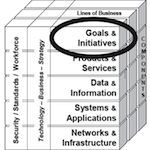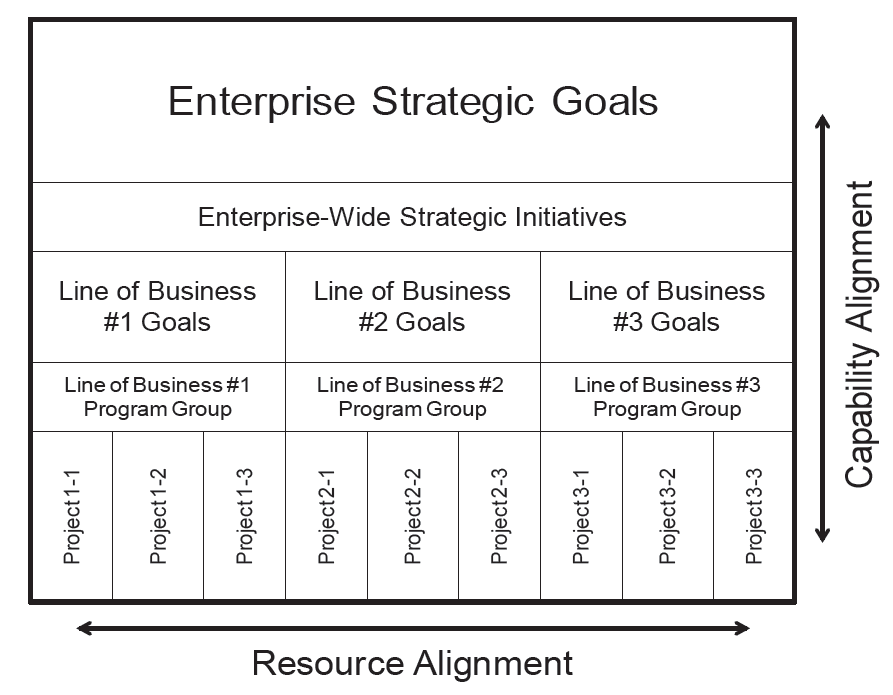 EA3 artifact S2: Strategic Plan
EA3 artifact S2: Strategic Plan
A Strategic Plan is a high-level policy and planning document that an enterprise uses to document its direction, competitive strategy, most important goals, and the enabling programs and projects (strategic initiatives). The Strategic Plan covers a future period, usually 3-5 years.
Description
A Strategic Plan is a composite EA artifact that should guide the enterprise’s direction over a 3-5 year period in the future by providing the following items, each of which are primitive (basic) EA artifacts. Full versions of abbreviated primitive artifacts are separate artifacts.
- Provide a Mission Statement and a Vision Statement that succinctly captures the purpose and direction of the enterprise.
- Develop a Statement of Strategic Direction that fits the enterprise’s purpose, ensures survivability, allows for flexibility, and promotes competitive success. This statement is a detailed description of where the enterprise intends to go.
- Summarize the results of a SWOT Analysis that is based on the statement of strategic direction and which identifies the enterprise’s strengths, weaknesses, opportunities, and threats. The full SWOT analysis is artifact S-2.
- Summarize the situation and planning assumptions for several ‘Concept of Operations’ CONOPS Scenarios that support the enterprise’s strategic direction. This summary should include one current scenario that describes at a high-level the coordination of ongoing activities in each line of business, as well as several future scenarios that account for different combinations of internal and external drivers identified through the SWOT Analysis. The complete scenarios are artifact S-3.
- Develop a CONOPS Diagram that in a single picture captures the essence of and participants in the current operating scenario. This graphic is artifact S-4.
- Develop a General Competitive Strategy for the enterprise that incorporates the current and future CONOPS scenarios and moves the enterprise in the intended strategic direction in a way that and address internal/external drivers such as culture, line of business requirements, market conditions, competitor strategies, and risk.
- Identify Strategic Goals that will accomplish the competitive strategy, and specify the executive sponsors who are responsible for achieving each goal. Identify Strategic Initiatives and resource sponsors for the initiatives, which are the ongoing programs or development projects that will accomplish each Strategic Goal.
- Summarize Outcome Measures for each Strategic Goal and Initiative, using the Balanced Scorecard™ or similar approach. The full scorecard is artifact S-5.
Mission Statement
An enterprise’s Mission Statement succinctly describes the purpose and direction of the enterprise. This statement should be long enough to get the point across but provide no detail (1-2 sentences is recommended). The Mission Statement answers the “who are we” question at the level of the entire enterprise.
Mission Statement Example – Business:
“The Acme Insurance Company provides high-quality, affordable business insurance to small business owners and farmers.”
Mission Statement Example – Government:
“The Orange County Highway Department provides safe and efficient roadways and bridges for pedestrian and vehicle traffic.”
Vision Statement
An enterprise’s Vision Statement describes in abbreviated form the competitive strategy of the enterprise. This statement should be short and memorable. The Vision Statement answers the “how are we getting there?” question at the level of the entire enterprise. The following are examples:
Vision Statement Example – Business:
“In offering unbeatable value and service, the Acme Insurance Company will be the insurance provider of choice for small business owners and farmers.”
Vision Statement Example – Government:
“State-of-the art planning, execution, and responsiveness will make Orange County’s roads and bridges the safest and most efficient in the State.”
Vision statements are more than advertising slogans, they are meant to help members of the enterprise understand the primary direction that is being pursued, and then be able to communicate that inside and outside of the enterprise.
Strategic Plan – Mapping Goals, Initiatives, Metrics
The Strategic Plan documents the primary purpose, goals, initiatives, and key outcome measures of an enterprise.

Strategic Plan – Mapping Projects and Goals
The Strategic Plan also documents the alignment of programs and resources with the goals of the enterprise.
